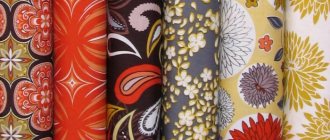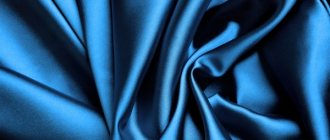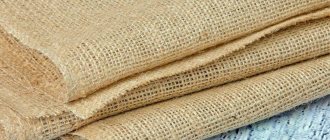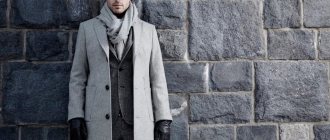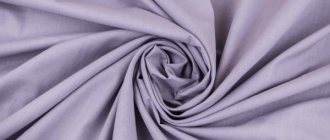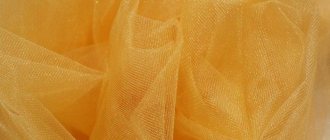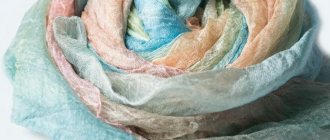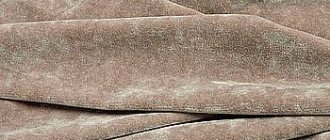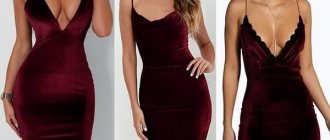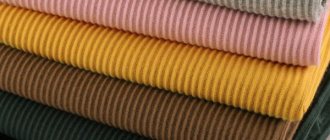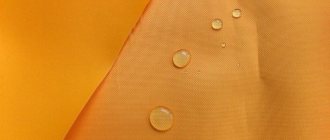Batiste is rightfully considered one of the most refined and sophisticated, light and airy fabrics. Today, the material is made not only from thin twisted fibers of cotton and linen, but even from synthetics, although natural fabrics are still preferable. There are different types of material: bleached, plain-dyed, printed. Some types are exposed to alkali to produce a smooth, more durable mercerized cambric. The material is used to sew clothes, bed linen and underwear, and to create decorative interior items.
What type of fabric is this?
Batiste is a light, airy and delicate fabric woven from thin fibers of cotton, synthetic, viscose and other threads. The most expensive material is made of linen threads.
Linen
Natural linen fabric - from a description of production to a review of characteristics
more details
Despite its fine texture and smoothness, cambric is quite durable. And this is achieved through plain weave. When impurities are added to the composition in the form of other fibers, the material acquires other properties.
Lawn fabric colors
Now cambric production has been established almost all over the world. However, the fabric that is most similar to the original is woven only in Italy, France, and Belgium. In these countries, hand-twisting of flax yarn is still used.
Not everyone can afford to wear products made from such material. And all because flax is grown on plantations specifically for these purposes and is carefully looked after. The result is flax fiber of the highest quality.
In factory production, other fibers are used, for example, synthetic and cotton. Although the fabric loses all its original attractiveness, it acquires other properties, for example, increased wear resistance.
But in this case, increased demands are placed on manufacturing: the fiber must be uniform in thickness over its entire length, only then can a perfectly even structure be obtained. Cotton for these purposes is grown in Peru and Egypt.
Care
Contaminants are easily washed off from cambric products, and they dry quickly. However, the fine fibers of the fabric are sensitive to repeated washing and require careful handling. When leaving, adhere to the following rules:
- Hand and machine washable on delicate cycle.
- Place cambric products into the drum only in a special bag.
- Squeeze carefully by hand or in a machine at a maximum of 400 rpm.
- Wash separately from other types of fabrics.
- Use detergents for delicate items.
- Avoid contact with metal fittings and sharp objects.
- Dry in a place protected from the sun.
- Iron at “linen” or “cotton” heating temperature.
- Before ironing, items should be dampened and a gauze iron should be used.
- Sewing products made from cambric should be done with a fine number of needles and threads.
Origin story
Baptiste has long been famous for its high cost, dating back to the 13th century. Previously, it was available only to the rich. It was then brought from India. Only the rich could afford to sew underwear, shirts, shirts or other items of clothing from cambric.
Baptiste was not always called that way. Its name was given in honor of the weaver J. Baptiste Cambrai, who in the 18th century unraveled the secret of weaving fibers. Then the material began to be produced in Flanders. In some European countries, the material was also called “cumbric”, this is also in honor of the master.
Since cambric was first made from linen fiber, which was spun by hand, garments made from this material indicated a person from high society. This fabric is even mentioned in some novels by writers of that time.
Baptiste in literature
In V. Hugo's story “The Last Day of a Man Condemned to Death” one can see evidence that cambric was considered the fabric of aristocrats.
“Suddenly one of the henchmen pulled off my jacket, and the other took my lowered hands, pulled them behind my back, I felt a rope wrapped around my wrists. Meanwhile, the second one was taking off my tie.
The cambric shirt, the only shred that remained of who I used to be, confused him for a moment; then he began to cut off her collar.”
The work was published in 1825 and caused heated debate among the intelligentsia.
Fabric composition and its properties
Thin, smooth and airy fabric can consist of fibers of different origins: linen, cotton, viscose or synthetics. The composition may even contain several types of fibers. The properties of the material depend on what they are. For example, synthetics can make cambric stronger and make the product easier to care for.
Properties:
Softness
Ease
Hygroscopicity
Breathability.
Does not cause allergies
Production technology
The cambric production technology has some features. In order for the fabric to be absolutely smooth, it must be made from completely even threads without any flaws.
Few manufacturers can produce threads of this quality. The best choice of raw materials for making cambric is considered to be cotton from Egypt and Peru.
Modern industry offers the consumer cambric with new and improved qualities, for example, mercerized. This type of fabric is obtained by treating the fibers with alkali and further washing them in water with a temperature difference.
Types of fabric
Main types:
Bleached
It is the finest snow-white fabric. It is practically lint-free. Soft and tender. Suitable for sewing underwear, children's clothing, wedding dresses.
Plain painted
Painted one color. Used for sewing curtains or bed linen, tablecloths, etc.
Printed
Batiste with a pattern. A variety of designs are applied, from polka dots to flowers. Used for sewing clothes from the summer wardrobe.
Mercerized
Thanks to the mercerization process, in which the fabric is treated with an alkali solution, washed off with hot and cold water, cambric acquires increased density, rich color, silkiness and gloss. The fabric is used to make not only clothes, but also home furnishings.
Jacquard
A jacquard pattern is applied to the fabric and clothes or scarves are sewn from it.
Embroidered
Embroidery is applied to the cambric.
Where is it used?
Batiste is used for everyday products:
- luxury bedding;
- underwear;
- things for sleeping;
- cambric handkerchiefs;
- napkins and tablecloths;
- summer clothes for women and children: dresses, nightgowns, blouses and dressing gowns;
- kits for newborns;
- furniture covers;
- light curtains decorated with sewing and lace;
- costumes for theatrical performances and masquerade;
- bride's wardrobe items and wedding accessories;
- gloves, belts, hair decorations;
- interior decor: panels and tiebacks for curtains.
The material is in demand among craftswomen. It is used for applique, embroidery, patchwork and quilling. Lawn combines simplicity and sophistication in an amazing way, so the fabric does not go unnoticed by fashion designers who create masterpieces.
Tips for choosing
Now there is a huge selection of cambric fabric on the market, not only in stores, but also on the Internet. To choose the right cambric, you need to pay attention to the composition of the fabric before purchasing. The highest quality cambric is natural, made from 100% cotton or linen; products made from it will be environmentally friendly, light, and breathable. If the fabric has additives, you need to take into account the percentage - natural fibers should be more than 50%. Before purchasing fabric, you need to correctly calculate the footage, since shrinkage occurs by 10%.
Important! For children, it is better to choose completely natural fabric, since synthetic additives can cause allergies or irritation to the skin.
Characteristics
Batiste fabric is actively used to create different types of products - both for wearing and for other daily use. To evaluate all the characteristics of the material, it is worth noting its advantages and disadvantages.
First, let's talk about the advantages that distinguish the canvas from others:
- High air throughput - in summer it is not hot, comfortable and pleasant in such things;
- Does not cause allergic reactions even on delicate skin;
- The fabric is very soft, weighs very little - it will be pleasant to wear;
- This material is very thin, which makes it easy to wash off dirt. Things dry quickly and are easily ironed;
- The products keep their shape despite their lightness and translucency - they do not stretch, do not deform, and do not shrink
We will explain what textiles are and what applies to them in another review.
Let's note the small shortcomings that are characteristic of any canvas:
- Requires delicate washing and careful care when caring;
- Light weight creates little difficulties in the cutting process;
- You can see what cambric fabric looks like in the photo and make sure that it looks quite simple.
It's time to note what density is inherent in cambric:
- Weave of threads – 20-30 threads per cm2;
- Surface – 7 g/m2.
You will find reviews of cambric tulle below! In the meantime, let's talk in more detail about what can be sewn from it - in production or by hand.
Flaws
Since cambric fabric has a low weave density, the products require hand or delicate washing. It is also better to squeeze them out manually or at minimum speed. This will avoid divergence of threads on the canvas and the formation of unwanted hemstitches.
Cutting thin cambric fabric is quite difficult, as it is quite slippery and easily moves on the work table. The best option would be to use a non-slip backing, such as a flannelette blanket.
It is better to dry cambric items in the shade, first turning them inside out to preserve the color. Exposing wet material to direct sunlight may cause the paint to fade. Basically, color fastness in this case will be determined not by the type of fabric, but by the composition of the dye.
Synthetic cambric only looks natural, but it causes allergies, like any other synthetic material.
In addition, this fabric is not suitable for evening dresses or products with complex silhouettes, since cambric is a loose and airy material, and therefore cannot hold its shape. And despite the average price category of this fabric, dresses and sundresses made from it look cheap. Therefore, sewing underwear from cambric is considered the most popular.
Reviews
Natalia, Ramenskoye
I purchased a set of cambric bed linen. My husband and I really liked it – it’s pleasant to the body, light, looks chic. It's warm to sleep on in winter, and cool to sleep on in the summer heat. The quality is not inferior to silk. Easy to wash and iron.
Olga Ivanovna, St. Petersburg
I bought a white cambric tablecloth, which I decided to decorate with embroidery. It was easy to embroider, you just need a thin needle. It turned out so beautiful! Guests come and express delight, and I myself can’t stop admiring it. I bought napkins for the set and now I will enjoy embroidering them.
Anastasia, Vladivostok
I just love cambric underwear! It looks simple, but it gives the most pleasant sensations - thin, breathable. My skin is prone to allergies; I cannot wear underwear containing synthetics. Previously, cotton was my salvation, now it’s only cambric!
